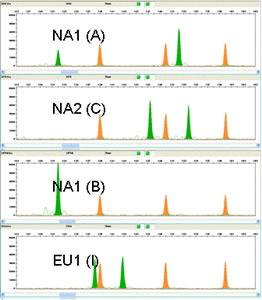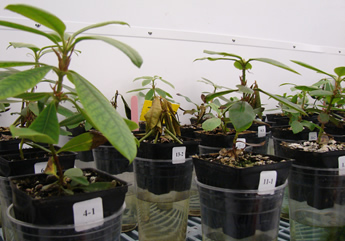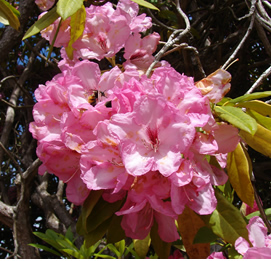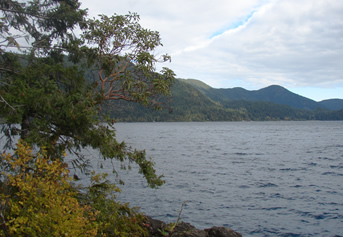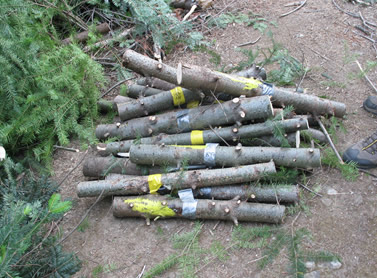Population genetics of Pr in WA-Research
gary.maguirePopulation genetics of P. ramorum in Washington State
Katie Coats, Gary Chastagner, Norm Dart, Meg M. Larsen, and Niklaus J. Grunwald
Contact: Gary Chastagner, 253-445-4528 | WSU Puyallup Research & Extension Center, 2606 West Pioneer, Puyallup, WA, 98371-4998 USA
Last updated January 2, 2013
Evaluation of fungicides for use against P. ramorum
gary.maguireEvaluation of fungicides for use against P. ramorum
The Forest Service, Washington State Pesticide Commission, Pacific Northwest Christmas Tree Association, IR-4 program, and the WSDA Nursery Research Program are supporting research at WSU Puyallup to determine the effectiveness of various fungicides in protecting conifers and rhododendrons from infection by this pathogen. This work has shown that several traditional contact materials, such as mancozeb, and the systemic material Subdue MAXX, have the potential to provide excellent control of diseases caused by P. ramorum. However, growers and regulatory agencies are concerned that the use of fungicides may be masking symptom development, thus making it harder to prevent the spread of this pathogen on infected nursery stock. Additional studies will be conducted at the National Ornamentals Research Site at Dominican University, California (NORS-DUC) to determine the residual effectiveness of fungicides and determine if any of them have the potential to mask symptom development on infected plants.
Publications
Effectiveness of fungicides in protecting conifers and rhododendrons from Phytophthora ramorum 220 KB
Gary A. Chastagner, Annie DeBauw, Kathy Riley, and Norm Dart
Cristi Palmer and Ely Vea. 2006. IR-4 Ornamental Horticulture Program Phytophthora Efficacy.
Chastagner, G.A., E.M. Hansen, K.L. Riley, and W. Sutton. 2005. Effectiveness of fungicides in protecting Douglas-fir shoots from infection by Phytophthora ramorum. Sudden Oak Death Science Symposium II, 18-21 January 2005, Monterey, CA.
Chastagner, G.A., E.M. Hansen, K.L. Riley, and W. Sutton. 2004. Effectiveness of fungicides in protecting Douglas-fir shoots from infection by Phytophthora ramorum. Phytopathology 94: S16.
Chastagner, G.A., E.M. Hansen. 2003. Identification of fungicides to control sudden oak death. Christmas Tree Lookout 36(3): 7-9.
Chastagner, G.A., E.M. Hansen, K.L. Riley, and W. Sutton. 2003. Identification of fungicides to control sudden oak death. In: Program and abstract book, sixth international Christmas tree research and extension conference; 2003 Sept. 14-19; Hendersonville, NC; 36.
Host Testing
gary.maguireHost Testing
Susceptibility, severity, and sporulation potential of Phytophthora ramorum on several Rhododendron species and hybrids
Marianne Elliott, Gary Chastagner, Katie Coats, Annie DeBauw, and Kathy Riley, Washington State University, Puyallup Research and Extension Center, 2606 W. Pioneer, Puyallup, WA 98371; melliott2@wsu.edu
Several plant genera are important in the spread of Phytophthora ramorum in nurseries. These include Rhododendron, Camellia, Viburnum, Pieris, and Kalmia. Very few studies have been done on these potentially important epidemiological hosts in nurseries. In an effort to reduce the risk of P. ramorum being introduced onto their sites, some nurseries have reduced or eliminated these species from their inventory.
Rhododendrons are an important nursery crop in the Pacific Northwest and have accounted for about 78% of the infected plants associated with positive nurseries in Washington since 2004. In an effort to identify the risk that certain Rhododendron species and hybrids pose in spreading this pathogen we have been examining the susceptibility and sporulation potential of P. ramorum on 42 Rhododendron species and 58 hybrids using an isolate of P. ramorum originally taken from Rhododendron. This isolate belongs to the NA1 lineage, which is the most commonly detected lineage of P. ramorum in Washington nurseries. Detached leaves were inoculated with a zoospore suspension on the upper and lower surfaces in both wounded and non-wounded treatments. Lesion area was measured after 5 and 10 days and production of sporangia and chlamydospores was assessed for each species and hybrid.
There was a great deal of variability among Rhododendron species and hybrids in their susceptibility to infection by P. ramorum, severity of symptoms, and production of sporangia and chlamydospores. Several species and hybrids could be considered resistant, with low incidence and severity of disease and low levels of sporulation. These would be good candidates for nursery production and possibly for future hybridizing material. Likewise, several species and hybrids that were very susceptible and supported high levels of sporulation were identified. In most cases lesions were larger on wounded than non-wounded leaves, and there was a higher infection frequency on the lower leaf surface than on the upper surface.
in
Proceedings of the Sudden Oak Death Fourth Science Symposium 2010
Susan J. Frankel, John T. Kliejunas, and Katharine M. Palmieri, tech. coords.
Gen. Tech. Rep. PSW-GTR-229. Albany, CA: U.S. Department of Agriculture, Forest Service, Pacific Southwest Research Station. 378 p
| abstract | poster |
Contact: Gary Chastagner, 253-445-4528 | WSU Puyallup Research & Extension Center, 2606 West Pioneer, Puyallup, WA, 98371-4998 USA
Last updated January 2, 2013
Pacific Northwest broadleaf hosts
gary.maguirePacific Northwest broadleaf hosts
One of the major factors that will affect the potential spread of Phytophthora ramorum in western Washington forests is the ability of this exotic pathogen to sporulate on known and potential hosts within these forests. In California, the ability of P. ramorum to produce large quantities of inoculum on California bay laurel is a major factor in the epidemiology of sudden oak death in their forest ecosystems. Tanoak appears to be the most important epidemiological host associated with the spread of P. ramorum in southwestern Oregon forests. In the United Kingdom, sporulation on rhododendron within forests appears to be responsible for the spread of this pathogen to several forest trees.
Western Washington is considered to be at high-risk for the spread of P. ramorum. Limited information is available regarding the sporulation of P. ramorum on hosts in western Washington forests. Research is underway to determine the potential for P. ramorum to sporulate on known and potential hosts that commonly occur in western Washington forests. This information will increase our understanding of potentially important epidemiological hosts and provide insights on the role they may play in the spread of P. ramorum in forest ecosystems where other important epidemiological hosts, such as California bay laurel and tanoak do not occur.
Studies with known conifer hosts, such as Douglas-fir, indicate that infection occurs during the early stages of shoot emergence. Thus, sporulation on hosts such as madrone and big leaf maple which potentially have foliage within the mid to upper canopy of the forest probably pose the greatest threat to spreading the disease to established conifers. Although one small preliminary study suggests that P. ramorum does not produce sporangia on infected Douglas-fir and grand fir shoots, additional tests are needed to confirm this and determine the potential for it to sporulate on other conifer foliage within Washington’s forests. Although potentially less important as a source of inoculum for standing trees, sporulation on understory shrubs, like Pacific rhododendron and salal, may be important sources of inoculum that may contaminate logs during harvest.
A laboratory study using detached leaves of some common broadleaf hosts found in the PNW was undertaken in summer of 2009 and 2010. Leaves were inoculated with a zoospore suspension of an NA1 isolate of P. ramorum and lesion area and infection frequency was evaluated. If P. ramorum was recovered from a leaf that did not show a visible lesion, it was considered to be infected asymptomatically. Sporulation potential of foliage of each plant species was also determined.
In general, the results of this study indicate that western Washington forests are not at high risk for damage caused by P. ramorum, based on the host plants tested. However, this is a subset of the many plant species that occur, and there may be a host species that is either extremely susceptible to infection or a prolific sporulator, that was not tested in this study. Plants posing the smallest risk of P. ramorum establishment were generally invasives and/or riparian species. The highest risk plants were commonly found in forested environments. These were fairly susceptible to infection and produced more chlamydospores than sporangia in their foliage.
Chlamydospore production was higher than sporangia production on many hosts in western Washington forests that were examined in this study. In other systems, such as bay laurel (Umbellularia californica) in California, and Rhododendron ponticum in the UK, P. ramorum outbreaks are driven by high concentrations of sporangia produced on foliage of these hosts. None of the Washington hosts tested produced as many sporangia as U. californica. Chlamydospores are a means by which P. ramorum can persist on a site in soil and decaying foliage, but will probably not produce large amounts of inoculum unless they germinate directly into sporangia, which can occur in flooded soils.
Publications
Phytophthora ramorum isolated from California bay laurel inflorescences and mistletoe: possible implications relating to disease spread 174 KB
Gary A. Chastagner, Kathy Riley, and Norm Dart
Contact: Gary Chastagner, 253-445-4528 | WSU Puyallup Research & Extension Center, 2606 West Pioneer, Puyallup, WA, 98371-4998 USA
Last updated January 2, 2013
Current California Oak Mortality Task Force Newsletter
gary.maguireStay up with the current California Oak Mortality Task Force with their Newsletter.
Phytophthora species move from native plant nurseries into restoration plantings
gary.maguireCheck out these photos of excellent examples of Phytophthora.
UC Berkeley Forest Pathology and Mycology Lab
gary.maguireLoose Leaf: The official blog of American Forests
gary.maguireLoose Leaf is a great blog on tree pests and what can be done to strengthen forests.
Potential for P. ramorum infection of conifer hosts
gary.maguirePotential for P. ramorum infection of conifer hosts
In spring of 2004, WSU initiated a research project to examine factors influencing P. ramorum infection in Christmas tree plantations with funding provided by a two-year USDA Forest Service grant. Work on this project is occurring at the Black Road Christmas Tree Farm near Los Gatos, CA. This is a 23-acre U-cut Christmas tree farm that was established in 1966. Conifers being grown at this site include Douglas-fir, grand fir, giant sequoia, scotch pine, white fir, and California red fir. Some known P. ramorum hosts in the forest adjacent to the edge of the farm include:
California bay laurel, madrone, big leaf maple, toyon, coast redwood, and tanoak. Dieback on some of the grand and Douglas-fir along the interface between the infected forest and the Christmas tree farm appears to have occurred at least 4 years previously, in 2000. During 2005, conditions were very favorable for disease development. Results from this study indicate that most of the infected Christmas trees occurred within 2 meters of the edge of the P. ramorum-infected bay laurel forest canopy. Virtually no infection was evident on Christmas trees that were >5 meters away from the forest edge.
Given recent developments in the UK, where P. ramorum is infecting conifers, further research at WSU-P is being done on the susceptibility of conifer species in western Washington forests.
Publications
In Frankel, S.J.; Kliejunas, J.T.; Palmieri, K.M.; Alexander, J.M. tech. coords. 2013. Proceedings of the Sudden Oak Death Fifth Science Symposium. Gen. Tech. Rep. PSW-GTR-243. Albany, CA: U.S. Department of Agriculture, Forest Service, Pacific Southwest Research Station. 169 p.
Symptoms Associated with Inoculation of Stems on Living Douglas-fir and Grand Fir Trees with Phytophthora ramorum 15 KB
Gary Chastagner, Kathy Riley, Katie Coats, Marianne Elliott, Annie DeBauw, and Norm Dart.
In Frankel, Susan J.; Kliejunas, John T.; Palmieri, Katharine M. 2010. Proceedings of the Sudden Oak Death Fourth Science Symposium. Gen. Tech. Rep. PSW-GTR-229. Albany, CA: U.S. Department of Agriculture, Forest Service, Pacific Southwest Research Station. 378 p.
Chastagner, G.A., E.M. Hansen, K.L. Riley, and W. Sutton. 2005. Susceptibility of conifer shoots to infection by Phytophthora ramorum. Sudden Oak Death Science Symposium II, 18-21 January 2005, Monterey, CA.
Chastagner, G.A., K.L. Riley, E.M. Hansen, and W. Sutton. 2004. Christmas tree and conifer nursery stock: Sudden oak death project update. Christmas Tree Lookout 37(3): 10-13.
Chastagner, G.A., E.M. Hansen, K.L. Riley, and W. Sutton. 2004. Susceptibility of conifer shoots to infection by Phytophthora ramorum. Phytopathology 94: S16.
Chastagner, G.A., E.M. Hansen, K.L. Riley, and W. Sutton. 2003. Susceptibility of conifer shoots to infection by Phytophthora ramorum. In: Program and abstract book, sixth international Christmas tree research and extension conference; 2003 Sept. 14-19; Hendersonville, NC; 10-11.
Contact: Gary Chastagner, 253-445-4528 | WSU Puyallup Research & Extension Center, 2606 West Pioneer, Puyallup, WA, 98371-4998 USA
Last updated January 2, 2013
